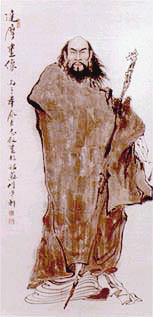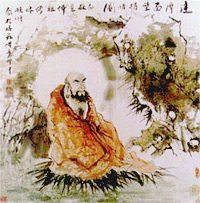|
|
Damo:
Conspiracy
of
Ignorance |
|
 |
Many
martial artists will have heard the story of Bodhidharma or Damo.
In the story, this Indian monk arrived in China, eventually
making his way to Shaolin temple on Mt. Songshan. There he found
the monks' physical condition poor and so unable to sit in
prolonged meditation. At first he was so disgusted that he
retired to a cave to sit in meditation for nine years. Then a
monk named Hui Ke cut off his own arm to show that he had
grasped Damo's deepest teachings. Damo then agreed to teach the
"Marrow Washing" and "Tendon Changing" classics as well as the
18 Lohan stances, a series of exercises meant to improve the
monks' ability to meditate. Many tellers add that these
exercises were derived from martial routines familiar to Damo
from his youth in a warrior caste family. In any case, the story
concludes that these exercises were to blossom into Shaolin kung
fu and are therefore the root of kung fu. It's a good story.
What a pity it is a fake.
This story has been under scrutiny in China for a very long time,
but gone largely unquestioned in the west. For example, Tang Fan
Sheng's 1930 book "A reference on Shaolin and Wudang," reports
that this fable can be traced back to a single source: the
preface by Li Jing to the "Marrow Washing Classic." Li Jing
states in this preface that he is writing in during the Tang
dynasty. Mr. Tang notes that the Shaolin monastery indeed held a
great attraction for literati who wrote many poems and essays
featuring the monastery during this time. Shaolin enjoyed such
fame not only because it held royal favor, but also because it
was also the fountainhead of Chan (Zen). However, Mr. Tang's
research finds many contradictions and anachronisms.
Perhaps the most glaring contradiction Mr. Tang considers is the
difference between Damo's actual teachings and those recorded in
the Classics. While Damo preached and practiced a method of
direct transmission of enlightenment, the heart and soul of Chan
teaching, the Classics are full of chants and "contortions."
Therefore, according to Mr. Tang, the contents are anathema to
Damo's aim and it is hard to believe that anyone living near the
time of Damo would have dared to pass on such an obvious
disparity. Still, there are even more concrete examples that
point directly to the piece's fraudulence. Among these obvious
mistakes is Li Jings report that Damo arrived in the Wei kingdom
during Xiao Ming's "Tai He" year. However, this would place
Damo's arrival more than 30 years before the establishment of
Shaolin at all. Someone writing at the time probably wouldn't
make such a mistake. Secondly, much of the text seem to be
copied directly from the "Transmission of Light," a largely
allegorical book describing Chan enlightenment which was not
written until the Ming dynasty.
Mr. Tang asserts that since the preface contained references to
the very real Hui Ke and Indian Buddhist scriptures, readers
accepted Li Jing as having lived during the Tang dynasty.
Further, he explains that many of the stories currently taken
for granted about Damo and the establishment of Shaolin kung fu
cannot be found in sources before the Ming dynasty. For example,
he notes that there are no stories of Damo staring at the wall
and leaving his shadow in the contemporary Tang dynasty accounts.
As a result of this discrepancy, Mr. Tang suggests the fable was
created in the late Ming or perhaps early Qing dynasties. Mr.
Tang's book is interesting to read as a piece that reflects its
own Republican era. He does not stop at researching the story,
but criticizes many books and materials published in his time
that not only advance the errors, but also compound them. For
example, one history of martial arts, which refers to the Damo
tale, reports that the kingdom of Wei was somehow in southern
China, while Liang was in the North..the complete opposite of
fact! Mr. Tang denounces his "modern contemporaries living in
this scientific age" for not doing more research before
transmitting fabrications.
Tang's findings are further supported by the work of Matsuda
Takatomo in his book "An Illustrated History of Chinese Martial
Arts," published in 1979. Matsuda revisits original sources as
well as work done by Tang Hao and Xu Ze Dong. He reports that
the Classics were supposedly published in 628 and yet according
to all findings, the oldest available copy was published in
1827, leaving a gap of approximately 1,200 years. During this
millennium and more, many books were published concerning
Shaolin martial arts. For example, "An Overview of Shaolin Pole
Techniques," the "Fist Classic," and "Collections of the Spirit
Hall." Oddly, none of these works mention Damo and stranger
still Matsuda reports that the words "Marrow," "Washing," or "Classic,"
are not to be found among their pages at all. Even books that
cover Buddhist history and lineage report only that "Damo lived
in Shaolin and sat in Chan meditation all day and all night,"
without any mention of a "Marrow Washing Classic." Mr. Matsuda
notes that during the Ming and Qing dynasties, it was very
common for writers to attribute their works to long-dead,
well-respected authors so that the piece would gain authenticity.
He therefore contends that late Ming or early Qing dynasty
martial artists borrowed Damo's name in order to increase their
own popular support and power.
Finally, "A Practical Guide to Chinese Martial Arts," written by
Kang He Wu in 1991 reviews the history of discovery, including
Tang Hao's work. In addition, he quotes monks interviewed in
1927 that report an oral tradition that the fist techniques that
now comprise Shaolin kung fu were brought into the temple during
the Song and Yuan dynasties. Before that, Shaolin techniques
were reported limited to staff fighting. In any case, Mr. Kang
also concludes that Damo is not the founder of Shaolin martial
arts.

For myself, I wonder why so many are so willing to believe in
this tale so deeply. Perhaps belief comes from faith in our
teachers? Perhaps there is a need to point to a single, simple
originator? Or perhaps the need to be as worthy as Hui Ke drives
us. Whatever the reason, perhaps we should take a moment to
reflect and wonder if the Damo story is nothing more than
allegory.
Text Contributed by Chris Toepker
Sources: www.hungkuen.net/history-damo.htm,
konghankungfu.com/myPictures/lohanShaolin.jpg,
www.hsuyun.org/Dharma/zbohy/VisualArts/ChineseArt/paintings.html
|